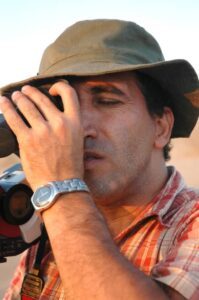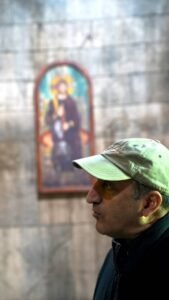 cinema cinemaVandad Alwandipur
cinema cinemaVandad Alwandipur
Mohammad Moghadam, born in 1344 in Tehran and graduated in graphics and cinema, is one of the few filmmakers who has been active in the field of making fiction, animation and documentary films in the past four decades, almost parallel to each other, and has outstanding works in all these different genres. He has it in his record. According to him, what caused his attachment to art was entering the libraries of the intellectual development center for children and teenagers and being in the center’s cultural and artistic atmosphere, which led him to participate in the center’s training classes in the fields of painting, theater, photography and cinema. The latter became his main hobby and made him choose cinema and graphics as his main field of study. Moghadam started experimental filmmaking in 1359 and has been active in the fields of title making, stage design and script writing in many documentary and fiction films and has participated in more than forty documentary, animation and fiction films as a writer and editor consultant. Mohammad Moghadam has written and directed more than 70 animes, short and long and experimental documentaries in his career. including two documentary series of 17 and 12 TV episodes and 10 animated short films. Among his notable animation works, we can mention “From Infinity” (1367), “The Gracious Tree” and “The Longest Journey in the World”, and among his documentary works, as an example, we can mention “Don’t get out of line, Mirror” (1364- Experimental ), “When you are asleep”, “Ver Jam”, “Kal Jeni”, “Until the dark end of spring”, “Ben Rood”, “Ham chun kuchei beis” (ten short films based on Ahmed Shamlou’s poems), “Gawkhuni” And called “Seal and Messiah”. So far, he has participated in more than fifty international film festivals and has won twenty national and international film awards and has been a judge in several domestic and foreign festivals. Among his other activities are participation in several biennials and group and individual exhibitions of photography and painting, editor-in-chief of two editions of Asifa animation specialized magazine and being on its board of directors, and four decades of presence in Asifa (International Association of Animation Makers) and publishing dozens of research articles in He pointed out the topics related to art, cinema, animation, and essays.
In an interview with Mohammad Moghadam, we asked his views about the different aspects of documentary cinema, in general, and especially documentary filmmaking in today’s world; Views that are interesting and remarkable in their own way.
If you agree, let’s start the conversation with a clichéd but fundamental question regarding the concept of documentary cinema: What is the relationship between documentary film and reality?
Documentary cinema has always included a wide range of events and worlds; From the small matters of life to the understanding of unknown cosmic phenomena. The viewer of the documentary film, according to an unwritten agreement arising from the word “documentary”, believes that all these aspects, whether they are very trivial in appearance, or very important and serious and universal, have a relationship with reality; But in the production of content called films and even documentary films, there is not necessarily such a ratio. In fact, it is the impact of the film and the impressionability of the audience that determines the position and value of the documentary film as a narrative of reality. How this narrative relates to reality depends on the filmmaker, how he looks at reality and reflects it.
It is obvious that the viewer of the documentary film, according to an unwritten agreement arising from the word “documentary”, believes that the documentary works, whatever they are about, always have a direct relationship with reality, and to put it simply, they are real; Whether the narrative represented in the film has a relationship with reality or at what level this relationship is, depends on the filmmaker’s perception of reality.
But in the end, it is the impact of the film and the impact of the audience and the interaction that has taken place in the meantime that gives credibility to the documentary film.
The debate about what reality is is a recurring debate. But I think that due to the simple and restrained and sometimes dumb concept of reality, and that reality for humans and basically every observer is tied to the phenomenon of representation, which itself can cause misunderstanding, especially in documentary cinema, where this representation (by the filmmaker) is consciously It happens, maybe the answer to two simple questions can completely clarify the concept of reality in general, and in relation to documentary cinema, and clear possible ambiguities: Is reality something common to all humans?, is what, for example, A hidden camera planted in a street is recording, is it real?
Please explain more about the documentary filmmaker’s view of reality.
See, we have a raw reality; Like the documentary images of the streets of Tehran in 1340, these images represent a reality for today’s audience that is completely different from the reality understood by the people of that period and may even be completely different for the people present in those images (it should be noted that the representation is completely different from reflection); Apart from the nostalgic feeling, which these images have in the first encounter.
But our readings of the images are mixed with interpretation, today’s audience, to a large extent, unintentionally compares the reality of those documentary images with the reality of today and with the historical events that have happened in the past sixty-two years, and this comparison and intervention and points of view. And the things that he unknowingly puts as the basis of judgment, he gives a new interpretation of the raw reality of those images that fits his time and views, awareness and preoccupations; And this interpretation is attached to his view of the reality represented by those images, and he sees another reality (another representation of reality) from the images of sixty-two years ago, which does not necessarily have a direct relationship with the images themselves. But those images, by themselves, are still a raw reality from that period. This change of view is true even for the old and black and white images of nature, because humans always perceive and receive reality through the lens of their eyes and the filter of their mind.
Regarding that other question: No; Reality is not something common to all humans; But each of the elements of reality can be something common to everyone; For example, in the example of street images, there are many elements such as a single tree, shops, geography seen on the street, people’s clothes, etc. But the type of composition of these elements and the importance of each of them in the eyes of each person and what things are priority for him and the type of mentality and interpretation and his look at the images determine the form of reality that he sees.
To give a simple example, in the pictures that we see today of the streets of Tehran sixty years ago, probably a common impression that we all have is the silence and light traffic of the streets, this comparison is obvious and inevitable, why what we see today is completely different. With those streets and following it, regret etc. is inevitable, and from this, one can add a thousand real, mental and fake narratives, that yes, because the streets were like that, everything else was a mess in that era.
Reality in the documentary film is concrete and not intrinsic, and in addition to the filmmaker’s view, which shapes the reality represented in the film, the viewer’s view also plays a role in making it, more or less, which is actually a reproduction itself. : The representation of reality from the filmmaker’s point of view, when it is seen from the spectator’s point of view, is represented once again in his mind and gaze based on the spectator’s gaze and interpretation. You see what a blur of parallel realities we have and at the same time with the same aspects!
In any case, the logical conclusion of this proposition is that documentary films are not necessarily more real than fiction films, and it is impossible to establish a boundary between documentary and fiction films..
Yes; What makes documentary cinema different from story-telling cinema, or can be the cause of this difference, is the documentary filmmaker’s way of looking at reality and the way he encounters phenomena and the answer he takes or extracts from them. Merely capturing images of real people and places does not make a documentary film.
The documentary film “A Man with a Video Camera” (the masterpiece of Zhiga Vertov-1929) is always a spectacular proposal to clarify this matter, that the audience’s relationship with the reality of the documentary film is not only the result of real images, but often the result of the filmmaker’s perspective and attention to his documentary method. .
This film contains a very important and practical trick and method in art and especially in cinema and especially in documentary cinema: the spacing that is done through the inclusion of a salvo from the cinematographer of the work, which is done in the middle of different sequences of the film that include scenes of the city and people. .
A form of suspending reality, adding to other dimensions and aspects of reality, this is the displacement and wonder of art. Regarding the topic of questioning and looking for answers that I mentioned, perhaps it is necessary to add this point that today, it rarely happens that our questions as documentary cinematographers do not lead to definitive answers. We see this uncertainty in a meaningful way in other matters as well; Like politics and economics. Perhaps this has caused our definitions of phenomena and concepts to be more fragile, complicated and temporary in some cases.
The phenomenon of fiction documentary or the combination of genres such as animation documentary, or the existence of a set of methods or styles of documentation in a single work, has become a common and sometimes inevitable thing today; And on the other hand, in fiction cinema, using the tone and atmosphere of documentary films or directly using documentary images is not a new thing.
All this reminds us that the separation of documentary cinema from story-telling cinema, that is, cinema based on drama and conflict and suspense, narration and the presence of actors, decor, and theatrical mise-en-scene, etc., alone cannot be a decisive separation or independent definition of this. There should be two forms of cinema, because we have seen many times that documentary cinema wanted and was able to use all the mentioned elements every time, but in the end it kept the title of documentary.
In my opinion, the stubborn effort that has been made over the decades to arrive at the classification and the inherent or concrete differences between documentary cinema and narrative cinema, has practically ended in a compliment on paper, because the empiricism aspect that exists in cinema as a whole is constantly Now challenging definitions are closed.
I basically do not agree with such definitions and boundaries. Of course, the separation of methods and genres is necessary for document classification and typology; such as zoo documentary or historical or social documentary. At the same time, this categorization is as general as if a Sengaki bakery writes Sengaki bread on its shop window. These categories were derived from a basic necessity that is related to the early decades of cinema history, when films were divided into silent and talking, romantic, historical and criminal. The academic form of it in Iran, for the first time 45 years ago, Dr. Hamid Nafisi in his valuable two-volume book; “Documentary film”, using the classifications made in the West, presented to the Persian-speaking audience, which has become a reference.
Those discussions have been done not once and for all, but enough to understand the typology of documentary cinema, and I don’t think there is a need to repeat them.
You mentioned the experimental aspect of cinema and that it constantly challenges boundaries. In your opinion, what has been the latest achievement of this experimentalism in cinema?
Maybe it was a phenomenon that I like to use the term “multi-genre” to name. A phenomenon that, in my opinion, is considered a fundamental evolution in cinema and has practically made it difficult to separate cinema into animation, documentary or story telling, etc. Once upon a time, these experiences were considered heresy and deconstruction, but today they have turned into handy techniques to increase the load and creatively look at reality and show the mental challenges of the filmmaker. So much so that cinema has inspired modern and even post-modern literature for many years, something that many literary greats of the world acknowledge.
